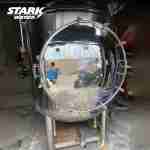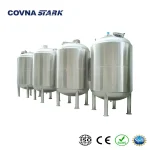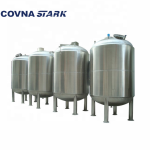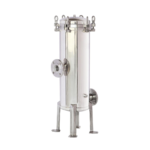In industrial environments, the cleanliness of a stainless steel water tank directly impacts water quality, equipment longevity, and even product safety. Improper maintenance can lead to biofilm buildup, scale deposits, and microbial contamination—all of which can disrupt operations and result in costly downtime or non-compliance.
Many businesses underestimate how quickly a poorly maintained tank can become a breeding ground for bacteria such as Legionella or lead to corrosion at weld points. This is especially critical in food processing, pharmaceutical production, and RO water treatment systems, where hygiene and water purity are non-negotiable.
Fortunately, with the right cleaning schedule and design features, stainless steel tanks are among the easiest to maintain in industrial applications. In this guide, we'll walk you through:
- When and why to clean your tank
- A step-by-step industrial cleaning process
- Tools and chemical agents you should (and shouldn’t) use
- Preventive maintenance strategies to reduce risk
- How STARK stainless steel tanks are designed for effortless cleaning and long-term durability
Whether you’re maintaining a single storage tank or overseeing a multi-stage water treatment system, this guide will help you reduce risk, extend your tank’s lifespan, and maintain system performance.
How Often Should You Clean a Stainless Steel Water Tank?
The cleaning frequency of a stainless steel water tank depends on several factors, including the tank’s application, water source, surrounding environment, and industry-specific hygiene standards. For high-purity or process-critical applications—such as RO water storage or food ingredient water—monthly to quarterly cleaning is recommended. In less sensitive uses, semi-annual or annual cleaning may suffice.
However, many facility managers delay tank cleaning due to perceived downtime or access difficulties. This can lead to serious operational risks, including:
- Biofilm buildup that harbors bacteria like Legionella, Pseudomonas, or E. coli
- Mineral scaling that affects water flow, pressure, and temperature control
- Corrosion under residue layers, even in stainless steel tanks, especially around welds or poorly drained bottoms
- Cross-contamination during CIP or system flushing cycles
Industrial audits and regulatory inspections frequently flag poor tank maintenance as a non-conformance point. In some sectors, such as pharmaceutical or beverage production, this can lead to full system shutdowns or product recalls.
To avoid these costly consequences, it's critical to adopt a proactive cleaning schedule and select tanks that are engineered for easy access, drainage, and sterilization—like the STARK stainless steel water tank, which is built with CIP compatibility and hygienic weld finishes in mind.
Step-by-Step Cleaning Procedure for Industrial Stainless Steel Tanks
Cleaning a stainless steel water tank is not just about flushing with water. Effective cleaning requires a structured, multi-phase approach to eliminate contaminants, scale deposits, and microbial risks. Below is a proven cleaning procedure suitable for most industrial-grade applications:
-
1. Drain the Tank Completely
Shut off all inlet and outlet valves and fully drain the tank. Use a dedicated drain port or sanitary bottom outlet to prevent residue accumulation. -
2. Rinse with Pressurized Water
Use high-pressure clean water to rinse the interior surface, focusing on corners, welds, and the bottom dome where sediment often accumulates. -
3. Apply Approved Cleaning Agents
Use a non-abrasive, stainless-steel-safe alkaline cleaner to remove organic matter and biofilm. For systems handling RO water or food-grade applications, ensure the chemical is certified for hygienic surfaces. -
4. Descale If Needed
In case of visible scale buildup, apply a diluted acid-based descaling solution (e.g., citric acid or phosphoric acid) under controlled conditions. Always rinse thoroughly afterward. -
5. Disinfect with Sanitizer or Steam
For high-purity systems, finish with a chemical sanitizer or a full-cycle SIP (Steam-In-Place) procedure. Ensure all surfaces reach the required contact time and temperature. -
6. Final Rinse and Air Dry
Use deionized or RO water for a final rinse to avoid mineral spotting. Leave the tank open (if allowed) for complete drying or use forced air circulation if enclosed. -
7. Visual and Gasket Inspection
Before returning the tank to service, inspect gaskets, weld lines, and manways for signs of degradation. Replace parts as needed.
STARK stainless steel tanks are designed with CIP spray balls, sloped bottoms, and sanitary outlet ports to support efficient cleaning and draining, helping your team complete the process faster and safer.
Recommended Tools and Cleaning Agents
Cleaning a stainless steel water tank is most effective when using the right combination of tools and approved chemical agents. Using incompatible or overly aggressive products can damage the tank's surface finish, reduce its lifespan, or leave behind harmful residues—especially in food, pharmaceutical, or RO applications.
Here are the most commonly recommended tools and materials for industrial tank cleaning:
- High-Pressure Water Jet or Spray Gun: For dislodging loose sediment and rinsing interior walls, especially at the bottom dome and near outlet ports.
- Alkaline Detergent (Food-Grade / NSF-Certified): Use mild, non-chlorinated cleaners specifically designed for stainless steel to break down organic biofilm and grease.
- Descaling Solution (Citric Acid or Phosphoric Acid): For periodic mineral removal. Avoid hydrochloric acid, as it can corrode stainless steel over time.
- Sanitizer or Disinfectant: Hydrogen peroxide, peracetic acid, or sodium hypochlorite (diluted) are commonly used for final disinfection. Choose agents compatible with your application.
- Clean-in-Place (CIP) System: STARK tanks support optional CIP spray balls or integrated nozzle systems, allowing automated internal cleaning without opening the tank.
- Non-Abrasive Brushes or Pads: For manual spot cleaning. Avoid metal brushes that may scratch or damage welds and inner surfaces.
To extend the lifespan of your tank and ensure regulatory compliance, always verify chemical compatibility with SUS304/SUS316 materials and follow the chemical supplier’s usage guidelines.
STARK stainless steel tanks are engineered with mirror-polished interiors, sanitary welds, and drainage-optimized bottom geometry—all of which simplify cleaning and reduce the need for aggressive chemicals or frequent manual intervention.
Preventive Maintenance Tips for Long-Term Performance
Even the most durable stainless steel water tank requires periodic maintenance to ensure long-term reliability, compliance, and operational safety. By implementing a consistent maintenance plan, you can extend your tank’s service life and avoid costly unplanned downtime.
Here are our top recommendations for effective preventive maintenance:
- Establish a Scheduled Cleaning Cycle:
Create a cleaning calendar based on your industry, application, and water source. For RO, food, and pharma-grade systems, this may mean monthly or quarterly cleaning. - Inspect Weld Seams and Tank Bottoms Regularly:
Use visual inspection and borescopes to check for early signs of pitting, discoloration, or scaling—especially in weld lines and outlet areas. STARK tanks use sanitary TIG welding to reduce these risks. - Check and Replace Gaskets or Seals:
Manhole gaskets, CIP port seals, and outlet flanges should be checked every 6–12 months for hardening, cracking, or microbial buildup. - Monitor for Dead Zones:
Ensure that tank geometry allows full drainage and that no residual liquid is pooling after emptying. STARK’s sloped bottom design with a center outlet minimizes this risk. - Avoid Contact with Chloride or Aggressive Cleaners:
Prolonged exposure to chlorine-based agents or salt-rich environments may initiate stress corrosion, especially in SUS304. Use compatible cleaning solutions and rinse thoroughly. - Log Each Maintenance Activity:
Maintain a tank-specific cleaning and inspection log, especially for industries with regulatory audits. Include time, personnel, agents used, and observations.
All STARK stainless steel tanks are engineered with maintenance in mind—featuring full-access manways, hygienic welding, and easy-to-replace components. With proper care, your tank can deliver 20+ years of consistent, compliant performance.
Why STARK Stainless Steel Tanks Are Easy to Clean and Maintain
At STARK, we understand that real-world industrial operations demand more than just strong materials — they require smart design, reliable logistics, and global compatibility. Our stainless steel water tanks are engineered not only for durability, but also for ease of cleaning, maintenance, and long-term integration into diverse systems worldwide.
With years of experience in exporting to North America, Southeast Asia, and the Middle East, our tanks have been successfully deployed in projects ranging from pharmaceutical cleanrooms and RO plants to firefighting systems in commercial complexes. Every unit is built to align with international installation standards and sanitation protocols.
Key features that simplify cleaning and maintenance include:
- Full-Access Manholes: Designed for easy inspection, manual entry, and compliance with audit requirements.
- Sloped Bottoms and Center Outlets: Prevent stagnant water accumulation and enable full drainage with minimal residue.
- CIP-Ready Nozzle Ports and Spray Balls: Built-in compatibility with clean-in-place systems reduces the need for manual cleaning.
- Mirror-Polished Interior Welds: Ensure smooth, residue-free surfaces that inhibit microbial buildup.
- Standardized Pipe Connections (DIN, ANSI, Tri-clamp): Facilitate global system integration with minimal on-site modification.
- Export-Ready Documentation: Includes material certificates, drawings, cleaning manuals, and CIF shipping support for international projects.
Whether you're installing a single tank or supplying a full-scale industrial system overseas, the STARK stainless steel water tank is built for long-term performance, simplified maintenance, and seamless international deployment.
Conclusion: Clean Smarter, Operate Longer
A well-maintained stainless steel water tank is essential for ensuring process efficiency, compliance, and water quality across industrial systems. With the right cleaning procedures, tools, and preventive strategies in place, your tank can serve reliably for decades.
STARK stainless steel tanks are engineered with maintenance in mind—featuring hygienic welds, CIP compatibility, slope-drain design, and international-standard ports. Whether you're managing a food-grade production line, RO system, or export project, we help you simplify operations while maximizing service life.
To learn more about technical specs, cleaning compatibility, or receive a tailored quote, contact us directly:
WhatsApp: +86 185 2015 1000
Email: [email protected]
Or visit the full product page:
STARK Stainless Steel Water Tank – Durable Industrial-Grade Liquid Storage Solution
Frequently Asked Questions
How often should I clean a stainless steel water tank?
Cleaning frequency depends on your industry and water source. For RO and food applications, cleaning is typically recommended every 1 to 3 months. For general use, every 6–12 months may be sufficient.
Can I use bleach or chlorine to clean a stainless steel tank?
Prolonged use of chlorine-based cleaners may cause stress corrosion, especially in SUS304. We recommend using food-grade alkaline cleaners and citric acid-based descalers, followed by thorough rinsing.
What cleaning agents are safe for SUS316 tanks?
Non-chlorinated alkaline cleaners, citric acid, phosphoric acid (in low concentrations), and hydrogen peroxide-based sanitizers are generally safe. Always verify compatibility with your tank supplier.
Do STARK tanks support CIP cleaning?
Yes. All STARK stainless steel tanks are CIP-ready, with integrated nozzle ports and optional spray ball systems that support full internal cleaning without disassembly.
How can I tell if my tank needs descaling?
Signs of scaling include reduced water flow, visible residue at the bottom, increased pump strain, or heat exchanger inefficiency. Regular inspection and pH testing help detect scaling early.





